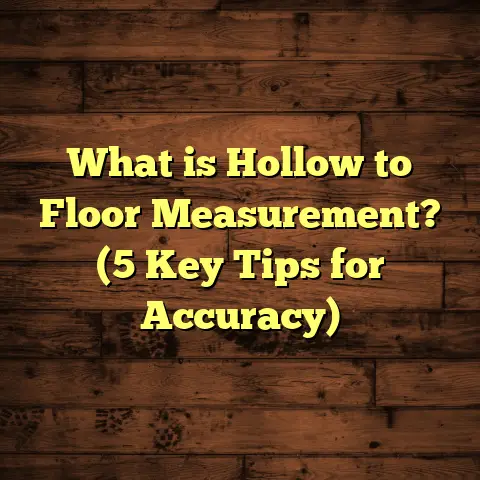What is Square Foot for Flooring? (5 Key Tips to Save Costs)
What if you could avoid spending hundreds or even thousands of dollars more than necessary on your flooring project just by understanding one simple measurement? Imagine buying flooring materials and hiring installers, only to find out you ordered way too much or too little material. That’s frustrating and expensive. Over the years, I’ve seen many homeowners—and even some contractors—stumble over the concept of square footage when it comes to flooring. This misunderstanding often leads to wasted money, delays, and stress. So, let me walk you through what “square foot for flooring” really means, why it matters so much, and share five practical tips based on my experience that will help you save money and hassle on your next flooring project.
What is Square Foot for Flooring?
When we talk about square foot in flooring, we’re referring to the total surface area that your flooring material will cover, measured in square feet (sq ft). It’s a simple concept: multiply the length of a room by its width, and you get the area in square feet.
For example:
- A room that is 12 feet long by 10 feet wide equals: 12×10=120 sq ft12 \times 10 = 120 \text{ sq ft}
That’s straightforward enough, right? But here’s where things get tricky.
Most rooms aren’t perfect rectangles. You might have closets, hallways, alcoves, or irregular shapes that complicate the calculation. For those, you’ll need to break the room into smaller rectangles or squares, calculate each area separately, then add them all together.
Why Does Square Foot Matter So Much?
You might wonder why this measurement deserves so much attention. Here are a few reasons:
- Material Ordering: Flooring is sold by the square foot. Knowing your exact square footage helps you order the right amount of material.
- Cost Estimation: Labor costs for installation often depend on the size of the area.
- Planning: Budgets depend heavily on accurate measurements.
- Avoiding Waste: Ordering too much material wastes money; ordering too little causes delays.
I once had a client who thought their living room was 200 sq ft but forgot to include the hallway leading into it. The actual area was nearly 300 sq ft — a massive difference when ordering materials.
If you underestimate square footage, you’ll need to order more later, potentially paying rush delivery fees or facing installation delays. Overestimating can mean leftover material you might never use.
Breaking Down Odd-Shaped Rooms
Here’s a quick example of how to handle an L-shaped room:
- Main section: 15 ft x 12 ft = 180 sq ft
- Extension: 6 ft x 8 ft = 48 sq ft
- Total: 228 sq ft
Add an extra 10% for waste and cuts: 228×1.10=250.8 sq ft228 \times 1.10 = 250.8 \text{ sq ft}
Always round up because it’s better to have a little extra than not enough.
My Journey with Flooring Measurements
Early in my career as a flooring contractor, I relied heavily on measurements provided by clients or real estate listings. I learned the hard way how risky that can be.
One memorable project involved installing hardwood floors in a roughly 1,000 sq ft home. The client gave me rough dimensions based on their floor plan. When I arrived with materials, I realized they had forgotten about an extra small bedroom off the hallway. The actual floor space was closer to 1,150 sq ft.
Because I double-checked measurements myself before ordering, we avoided major headaches. If I hadn’t caught that extra space early, we would have had to place a second order—leading to delays and extra shipping costs.
That experience taught me two lessons:
- Never trust rough measurements blindly.
- Always measure yourself or hire a professional to do it.
Over time, I developed a simple checklist I use on every project to ensure accuracy:
- Measure each room independently.
- Include closets, hallways, and any connected spaces.
- Break irregular shapes into smaller rectangles.
- Add a waste factor based on room complexity and flooring type.
- Re-measure before ordering.
These habits have saved my clients thousands over the years.
Tip #1: Measure Twice (or Thrice), Order Once
This may sound like a no-brainer, but you wouldn’t believe how often people skip this step or do it poorly.
Measuring twice means taking initial measurements then checking them again later—maybe even a third time if your floor plan is complex. Use a tape measure or laser distance measurer for better accuracy.
Write down all measurements in a notebook or spreadsheet. If you have multiple rooms or odd shapes:
- Draw a rough sketch of each area.
- Label dimensions clearly.
- Calculate the area of each section separately.
- Add areas together for total square footage.
For example, an L-shaped family room might be divided into two rectangles:
| Area | Length (ft) | Width (ft) | Square Feet |
|---|---|---|---|
| Main Room | 20 | 15 | 300 |
| Extension | 10 | 6 | 60 |
| Total | 360 |
Add waste (let’s say 10%): 360×1.10=396 sq ft360 \times 1.10 = 396 \text{ sq ft}
Round up to nearest whole number: order 400 sq ft.
Tools That Help
I recommend investing in a laser distance measurer if you plan multiple projects or just want precision. They cost between $30-$100 and can save hours of measuring time.
Apps like FloorTally also help by letting you input dimensions and automatically calculating totals including waste factors.
The key takeaway: Don’t rush this step.
Tip #2: Account for Waste and Material Cuts
Even if you measure perfectly, some material goes to waste during installation.
Why? Because:
- Flooring needs to be cut around corners.
- Planks or tiles must fit irregular spaces.
- Some pieces get damaged during handling.
- Patterns or designs require specific cutting strategies.
The amount of waste depends on:
- Type of flooring (laminate vs hardwood vs tile).
- Room shape and complexity.
- Installation pattern (straight vs diagonal).
Industry standards suggest adding 5% – 15% extra material for waste:
| Flooring Type | Waste Factor Estimate |
|---|---|
| Laminate | 5% – 8% |
| Vinyl Plank | 5% – 10% |
| Hardwood | 8% – 12% |
| Tile | 10% – 15% |
If your room is rectangular with straight plank installation, aim for the lower end (5%-8%).
If your room has many corners or you’re installing diagonally, add more—up to 15%.
I once installed tile floors in an older home with lots of angled walls and steps. We ended up using almost 18% waste because cutting tiles to fit those odd shapes generated so much scrap.
Adding this buffer upfront avoids last-minute orders and costly rush fees.
Tip #3: Don’t Forget Doorways, Transitions & Stairs
People often forget to add flooring needed for transitions between rooms or thresholds at doorways.
For example:
- Door thresholds require strips or additional cuts.
- Staircases need tread materials (not always included in main floor calculations).
- Closets and entryways should be measured separately if they’re not part of main room dimensions.
In one project, I underestimated how much material was needed for transitions between hardwood floors and tile in the kitchen doorway. The client ended up paying an extra $200 for additional materials ordered mid-project.
Make sure these areas are factored into your total square footage estimate:
| Area Type | How to Measure |
|---|---|
| Door Thresholds | Measure doorway width and add a few inches for overlap |
| Stair Treads | Measure tread width x depth x number of steps |
| Closets | Measure length x width inside closet area |
These smaller areas can add up quickly—especially if you have multiple rooms with thresholds or stairs.
Tip #4: Understand Local Pricing for Materials and Labor
One thing I’ve learned over time is that pricing varies widely by location.
Material costs differ based on availability and brand preferences in your region. Labor rates also fluctuate depending on local demand and contractor experience.
To give you an idea, here’s how average prices compare across three U.S. cities per square foot (materials + labor):
| City | Material Cost per sq ft | Labor Cost per sq ft | Total Cost per sq ft |
|---|---|---|---|
| New York City | $6 – $12 | $3 – $7 | $9 – $19 |
| Dallas | $4 – $8 | $2 – $5 | $6 – $13 |
| Chicago | $5 – $10 | $3 – $6 | $8 – $16 |
Knowing these numbers helps set expectations about your budget. It also helps decide whether a DIY approach is feasible or if hiring pros makes more sense financially.
If you want to estimate costs accurately for your area, I recommend online tools like FloorTally that pull local pricing data into their calculations.
Tip #5: Shop Smart by Comparing Price Per Square Foot
Not all flooring materials are priced equally when compared per square foot.
Here are typical retail price ranges per square foot for common flooring types:
| Flooring Type | Price Range per sq ft |
|---|---|
| Laminate | $1 – $5 |
| Vinyl Plank | $2 – $7 |
| Hardwood | $5 – $15+ |
| Ceramic/Porcelain Tile | $1 – $20 |
I once helped a client decide between vinyl plank ($5/sq ft) and engineered hardwood ($12/sq ft). While hardwood was pricier upfront, it offered better durability and resale value.
When shopping:
- Factor in not just price but durability and maintenance costs.
- Check if prices include underlayment or other extras.
- Look for sales or bulk discounts.
- Consider local supply stores versus big box retailers.
By comparing cost per square foot carefully, you can find options that fit your budget without sacrificing quality or style.
Going Deeper: How Flooring Type Affects Square Foot Calculations
Not all flooring types behave the same when calculating how much material you need. Let me break down some major types and what that means for your measurements and waste factors.
Hardwood Flooring
Hardwood planks are sold by the square foot but come in fixed plank sizes. This means you’ll have leftover pieces when cutting around corners or fitting into irregular spaces.
Because hardwood is relatively expensive ($5-$15+/sq ft), it pays to measure very precisely but still add about 8%-12% waste for cuts and mistakes.
Hardwood also requires underlayment and sometimes additional materials like adhesives or nails—these won’t affect square footage but impact overall cost.
Laminate Flooring
Laminate is easier to cut than hardwood and typically comes in larger planks that snap together. Waste percentage tends to be lower—around 5%-8%.
Laminate is usually less expensive ($1-$5/sq ft). Because it’s cheaper and easier to install (even DIY), some people order less waste material than recommended—this sometimes backfires if they underestimate cuts for doorways or closets.
Vinyl Plank Flooring
Vinyl planks are becoming very popular due to waterproof qualities and ease of installation.
Waste factor ranges from 5%-10%, depending on layout complexity.
Vinyl plank prices vary widely from $2-$7/sq ft depending on brand and quality.
It’s important to measure stair treads separately if you’re covering stairs with vinyl plank since stair pieces are sold separately.
Tile Flooring
Tile installation is often the most complex when it comes to measuring square footage due to grout lines, cuts around corners, and patterns.
Waste can be as high as 10%-15%, sometimes even more in older homes with uneven floors requiring extra cuts.
Tiles come in various sizes from small mosaics (which generate more waste) to large format slabs (which require fewer cuts).
When ordering tile, also consider additional materials like grout and thinset mortar—they aren’t sold by square foot but add cost.
Real-Life Examples From My Projects
Here’s a few stories that show how understanding square footage saved my clients money—or cost them extra when ignored.
Example #1: Underestimating Leads to Delays
A family wanted new hardwood floors in their entire first floor—about 1,200 sq ft based on their rough calculations. They ordered just enough wood for that amount plus 5% waste.
After ripping out old carpet and subfloor prep began, we realized the actual area was closer to 1,350 sq ft because they hadn’t included closets and laundry room floors correctly.
We had to order an emergency shipment which took two weeks—pushing back their project timeline substantially and costing rush delivery fees ($350+).
Lesson learned: measure carefully before ordering!
Example #2: Smart Shopping Saves Thousands
Another client wanted luxury vinyl plank flooring for a new home addition totaling about 500 sq ft. Their initial budget was tight at about $3/sq ft installed ($1,500 total).
I helped them measure precisely (including waste) at about 540 sq ft needed. Then we compared brands online plus local stores:
- Brand A: $3/sq ft installed
- Brand B: $2/sq ft installed
We went with Brand B saving them nearly $270 upfront—but they got similar quality material with a longer warranty from Brand B’s supplier through my contacts.
Smart measuring + smart shopping = big savings!
More Tips & Tricks Based on My Experience
Use Online Calculators Like FloorTally
I’ve been using FloorTally myself for years now. It lets me input room dimensions, select flooring types from many options, factor waste percentages automatically, then gives me detailed cost estimates using local pricing data for materials and labor.
This tool cuts down guesswork drastically—and keeps budgets realistic from day one.
Don’t Forget Subfloor Prep Costs
Sometimes people forget subfloor preparation isn’t included in square footage calculations—but it can add hundreds or thousands of dollars depending on condition of existing floorboards or concrete slab quality.
If your subfloor needs leveling or repair prior to flooring installation, budget accordingly—even if your square footage is accurate.
Ask About Installation Patterns
Diagonal installations or herringbone patterns look great but increase cutting waste—sometimes as high as 20%.
If you want these fancy patterns, add extra material to your order beyond standard waste recommendations.
Store Leftover Material Properly
If you end up with leftover flooring pieces after installation—store them safely in case of future repairs!
Keep them in original packaging away from moisture and direct sunlight. Some manufacturers offer extended warranties if you can provide proof of leftover material for repairs later on.
Final Thoughts
Understanding what square foot means in flooring projects isn’t complicated once you know what to look for—but it takes attention to detail.
Accurate measuring saves money, reduces stress during installation, avoids delays—and helps keep your whole project running smoothly from start to finish.
From my experience as a contractor working on dozens of projects ranging from small kitchens to multi-thousand-square-foot renovations:
- Always measure carefully yourself or hire professionals who do.
- Don’t skimp on waste allowance—be realistic about cuts needed.
- Include doorways, closets, hallways, stairs in your totals.
- Understand local pricing for materials and labor before budgeting.
- Shop smart comparing price per square foot across brands and types.
- Use online tools like FloorTally for accurate estimates.
- Plan for subfloor preparation costs separately.
- Store leftover materials safely for future repairs.
Have you ever had a flooring project go wrong because of measurement errors? Or found ways to save by shopping smart? Feel free to share your stories or ask questions—I’m always happy to help!
Knowing your true square foot means knowing your costs—and that knowledge puts you ahead when planning any flooring job.





